Among the holdings of the DAI Athens archive, there is a fragmented personal diary whose author had not been identified until recently, as the handwriting, a hastily written cursive script (›Kurrentschrift‹), is difficult to read. In early April 2022, Katharina Brandt identified the author as the astronomer Johann Friedrich Julius Schmidt, who was born in Eutin on October 26, 1825 (fig. 1).
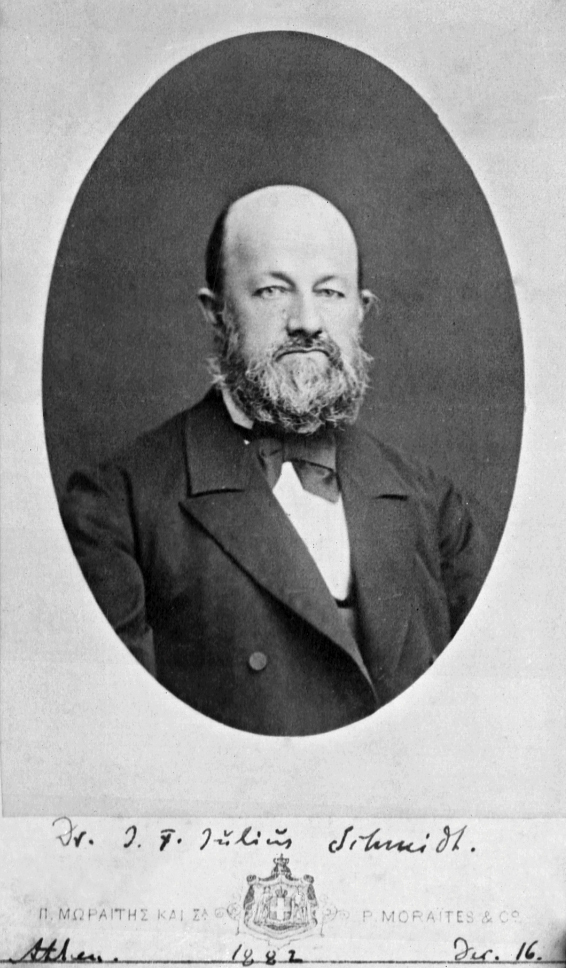
In light of this discovery, the value of the personal document became clear. Consequently, the author of this article undertook a transcription and edition of the diary and a social-network analysis of the people mentioned in it as part of her MA thesis at the University of Vienna. The goal was to contextualize and highlight Schmidt’s personal life, about which, in contrast to his astronomical work, little was previously known. As a result, it became evident that Schmidt was well-connected in astronomical circles and a valued member of Athens’ society.
In order for the incomplete and fragmentary diary to be dealt with and studied further, Persefoni Dimitrakopoulou restored it in 2022 as part of her own MA thesis at the University of West Attica, Department of Conservation of Antiquities and Works of Art (Persefoni Dimitrakopoulou, ›Study and conservation of modern manuscripts. The Case of Personal Diaries and Work Journals‹ (fig. 2), supervised by Konstantinos Choulis). Dimitrakopoulou’s preparation of the diary included careful documentation of its status (i.e. a detailed conservation report), dry cleaning of the leaves with a brush, removal of stains with a polyvinyl eraser, the smoothing of the paper edges, the repair of damaged leaves with Tengujo and Kozu Shi-Paper and the removal of the binding. In the restoration process, the binding was resown with linen thread, missing pages were supplemented with empty sheets, the surviving back cover was reinforced with Kozu-Shi paper, a new spine sown together with linen thread was provided and a new front board, similar in style to the back, was attached. Finally, a hollow spine was created to enable handling and the new front board was covered with a marbled paper resembling the original on the back cover (Dimitrakopoulou 2023).

Schmidt’s passion for astronomy started at the young age of 16, when he visited the observatory in Altona and the director showed him how to observe stars. Although Schmidt never studied astronomy or physics formally, he got his first job at the Bilk observatory near Düsseldorf four years later and became an assistant at the Bonn observatory in 1846. In 1853 he was appointed as director of the Olomouc observatory, which commenced a formative period of his career (Matsopoulos 2022). Since Olomouc is a day’s journey from Vienna, Schmidt could build both astronomical and personal networks with many people there, such as Simon von Sina, whose father Georg von Sina had financed the construction of the Athens observatory (fig.3). In Vienna, Schmidt met fellow astronomer and mathematician Demetrios Kokkidis. In 1858 Schmidt was appointed as the director of the Athens observatory by Simon von Sina, who was his employer until 1876. After Sina’s death in 1876, his widow continued to employ Schmidt until his own death in early 1884 (Matsopoulos 2022). Schmidt’s personal diary (1862–1882, D-DAI-ATH-ARCHIV-NL-Schmidt-00002) serves as the source for this blog post, which will explore the relations between Schmidt and the people at the DAI.
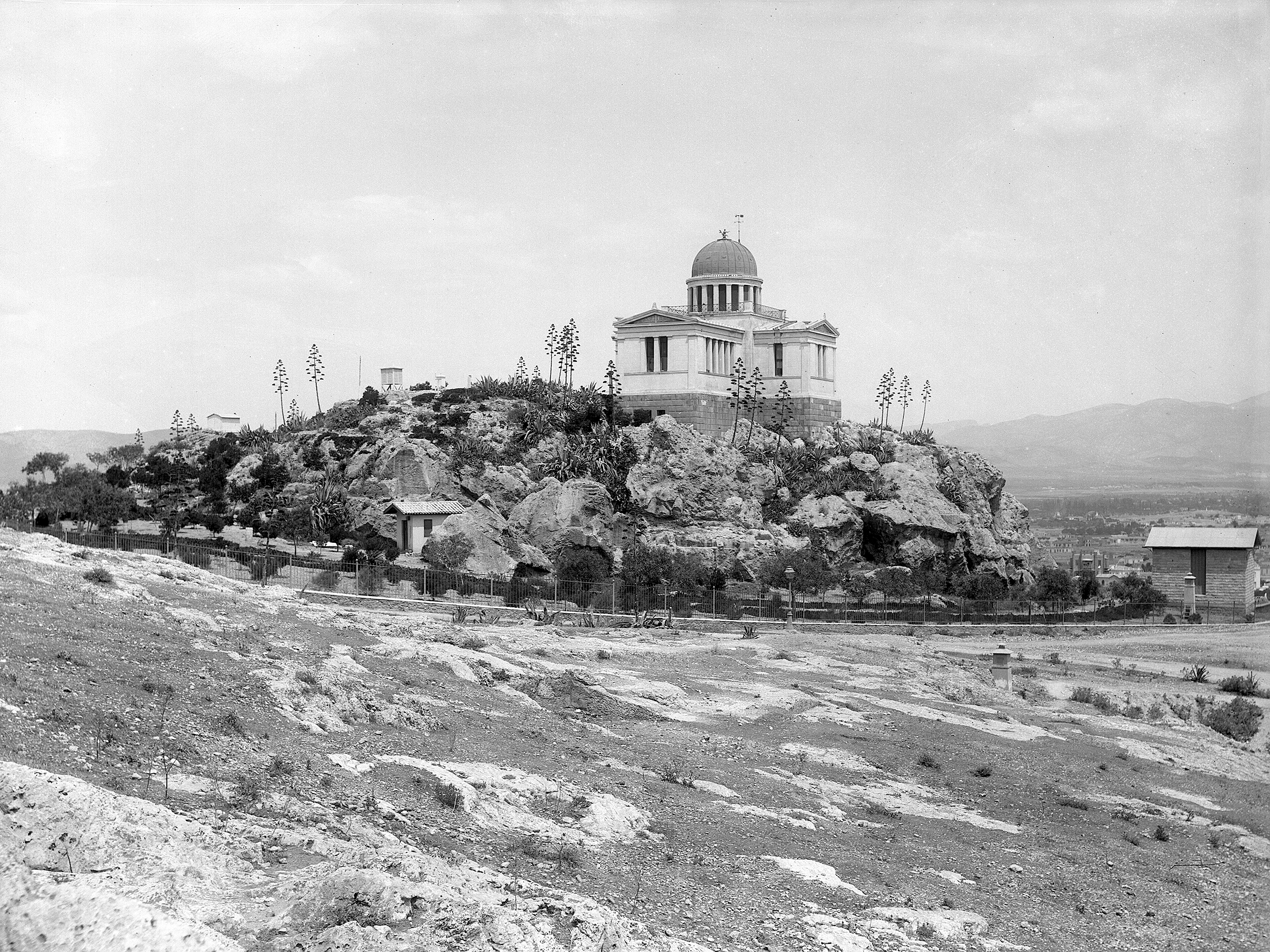
The 26 years that Schmidt lived and worked in Athens were a formative period for the city as much as for the DAI, and Schmidt recognized it as such in his personal diary (D-DAI-ATH-ARCHIV-NL-Schmidt-00002). He noted both important events in the city and his daily encounters with people living in or visiting Athens. While his diary entries certainly do not reflect all of his social encounters every day, they give insight into his personal network and allow glimpses into his closest friendships. Schmidt makes almost no mention of his astronomical work in his personal diary; he appears to have kept his professional observations in separate notebooks. Altogether, his diary entries mention 1,042 people from all over the world and from all kinds of social and economic backgrounds. Since Schmidt carefully documented most of his social connections, his network gives us hitherto unknown glimpses of nineteenth century Athens and Schmidt’s view of the everchanging city. Although Schmidt usually wrote in passing about daily occurrences, the diary gives insight into his personal beliefs, values, and opinions. The process of transcription and editing revealed that the renowned astronomer Schmidt also had a great appreciation of and interest in archaeology. This led him to participate in the search for Troy with the Austrian diplomat Johann Georg von Hahn in 1864 (Hahn 1865, 5). Schmidt’s diary covers the years 1862 to 1882 but is incomplete, as an unknown number of pages at the beginning have been lost (fig. 4).
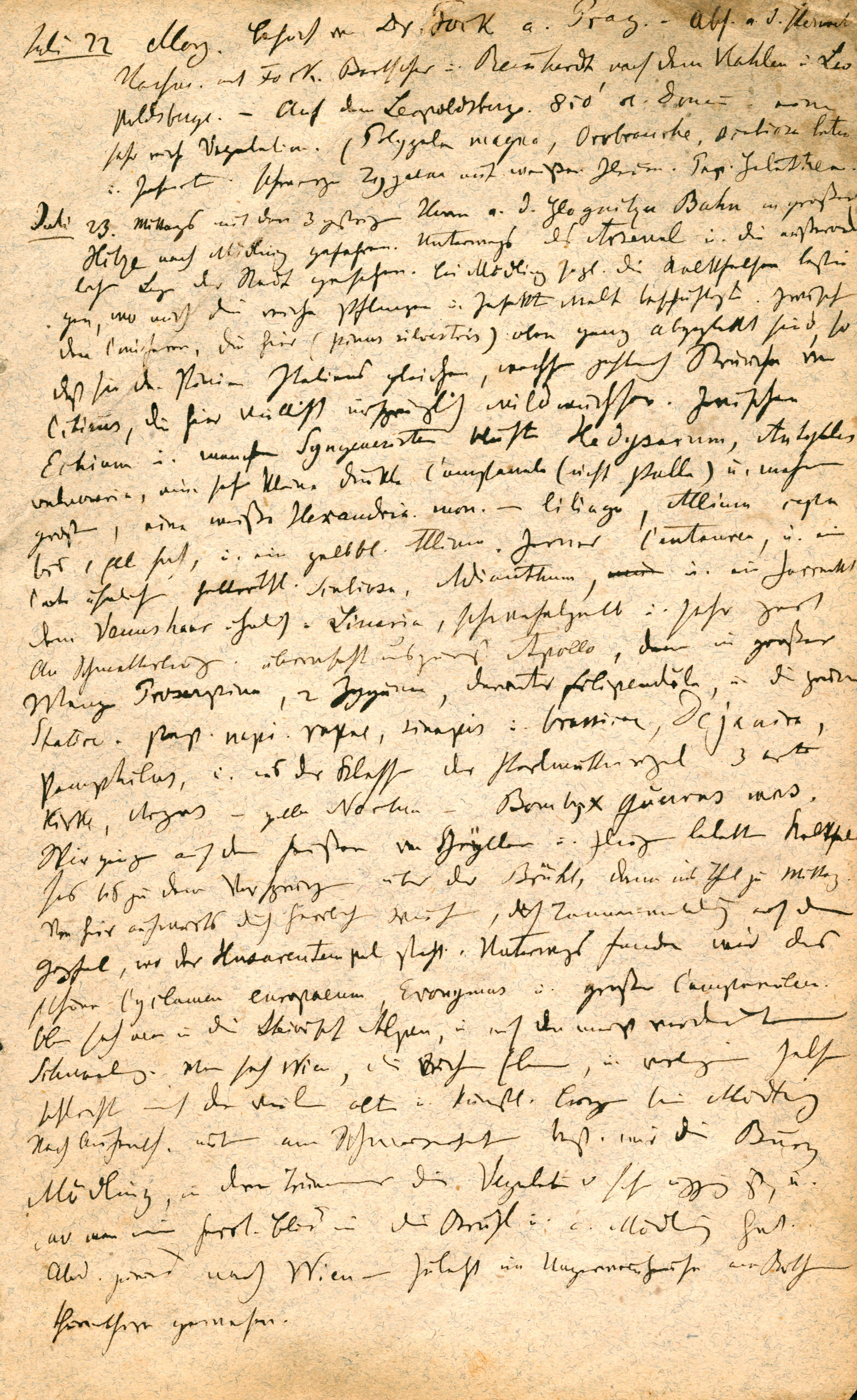
When Schmidt first came to Athens in 1858, he was not yet as well-known as he would become in the next decade and had not yet completed his most celebrated work, the »Charte der Gebirge des Mondes« (Schmidt 1878), a map of the moon. Schmidt appears to have been a charismatic person, who liked to network and meet new people. In Athens, he quickly became acquainted with the bookseller and publisher Karl Wilberg (Brandt 2022) and the botanist and director of the Royal Garden, Theodor von Heldreich, as well as many people from the royal court. He also frequently met visitors to the city.
Schmidt’s relations with people associated with the DAI Athens began many years before the Institute was even founded. When the first DAI travel grants for Greece were funded in 1860, Schmidt became acquainted and even friends with the then very young Adolf Michaelis. It is evident that he also met Alexander Conze, who is mentioned in the diary a handful of times in later years. Record of this acquaintance cannot be found in the diary, since the pages concerning these early years are missing, but the letters of Michaelis (Errington 2017, 435) attest that he and Schmidt frequently had lunch and dinner together and took short trips to visit various sites around the city (Errington 2017, 440). At the time, Schmidt was living in the house of Karl Wilberg, which became an important meeting place for young archaeological scholars (Errington 2017, 435). It thus is possible that Michaelis was instrumental in inspiring Schmidt’s subsequent interest in archaeological sites. In December of 1860, shortly after Michaelis left Athens, a series of earthquakes struck the area around Corinth. Schmidt, who was an avid observer of seismic activity in Greece, noted in an 1881 publication that he had visited the area immediately after the earthquakes had struck (Schmidt 1881, 65). In the holdings of its archive, the DAI Athens possesses a »Plan der Isthmischen Heiligtümer« (›map of the Isthmian sanctuary‹), signed by J. F. J Schmidt and dated to December of 1860 (D-DAI-ATH-Archiv-NL-Schmidt-00001). This document proves that during his visit to record seismic data, Schmidt also drew the map of the sanctuary, which constitutes the earliest evidence of his growing interest in archaeological sites (fig. 5).
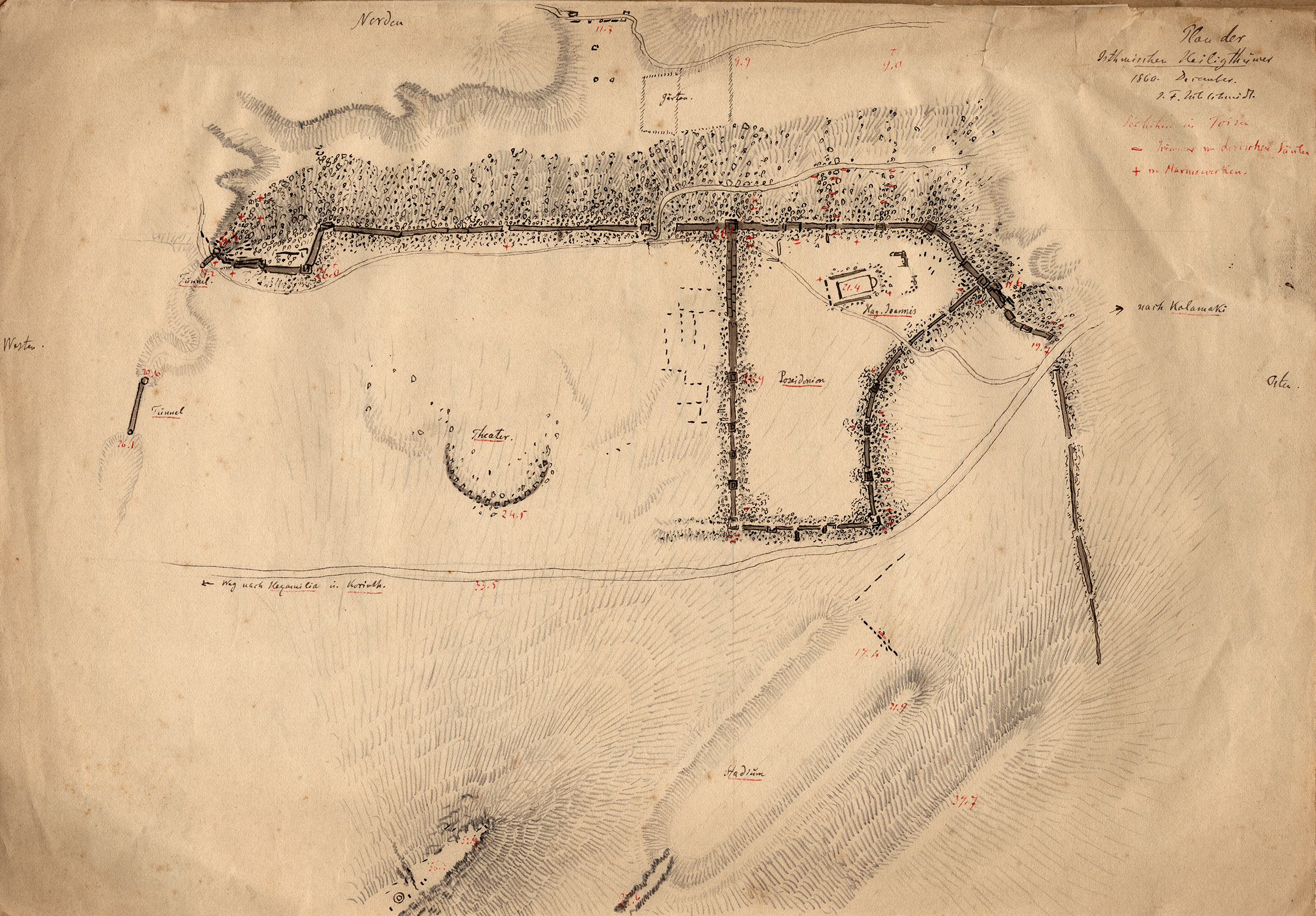
Although, we cannot pinpoint when Schmidt’s interest in archaeology started, his acquaintance with Michaelis seems to have inspired him to take action and map the visible remains of the sanctuary at Corinth. While Michaelis is not explicitly mentioned elsewhere in the diary and did not visit Athens during the 1870s and early 1880s, he frequently relayed greetings to Schmidt in letters to other people at the DAI Athens such as Ulrich Köhler (D-DAI-ATH-ARCHIV-K-00002_00061) and even occasionally referred to his friend as »Papa Schmidt« or »Effendi Schmidt« sometimes (D-DAI-ATH-ARCHIV-AK-K-AK-0001. I thank Katharina Brandt for this information).
In spring 1862, Schmidt met Ernst Curtius during the latter’s excavation of the Theatre of Dionysos with Karl Bötticher and Johann Heinrich Strack (Kern 1903, 580–597; Wieseler 1862, 749; Dörpfeld 1896, 1; Curtius 1868, 1). Schmidt also mentioned Curtius’ excavation of Philopappos Hill in Athens, as well as Mounychia Hill in Piraeus before he left for Berlin on May 2, 1862 (D-DAI-ATH-ARCHIV-NL-Schmidt-00002, 1) (fig. 6).

His acquaintance with Curtius solidified Schmidt’s archaeological interest, which continued over the next 24 years. During Curtius’ campaign to map Athens, which began in 1862 (Curtius 1868, 1), Schmidt provided measurements of the altitude of notable topographical features of the city (Curtius 1868, 1; 62). As an astronomer, he had the necessary tools to give accurate coordinates, for which one required a large meridian telescope at an observatory as a starting point to determine longitude and latitude and a portable barometer for altitude measurement used at the desired location. Since Schmidt was the director of the Athens observatory, he was able to provide his knowledge and access to the meridian telescope and was therefore instrumental in Curtius’ mapping projects (Curtius – Kaupert 1878, 9). Schmidt frequently refers to ancient monuments and drew the cityscape of Athens as seen from his balcony in his diary (fig. 7).
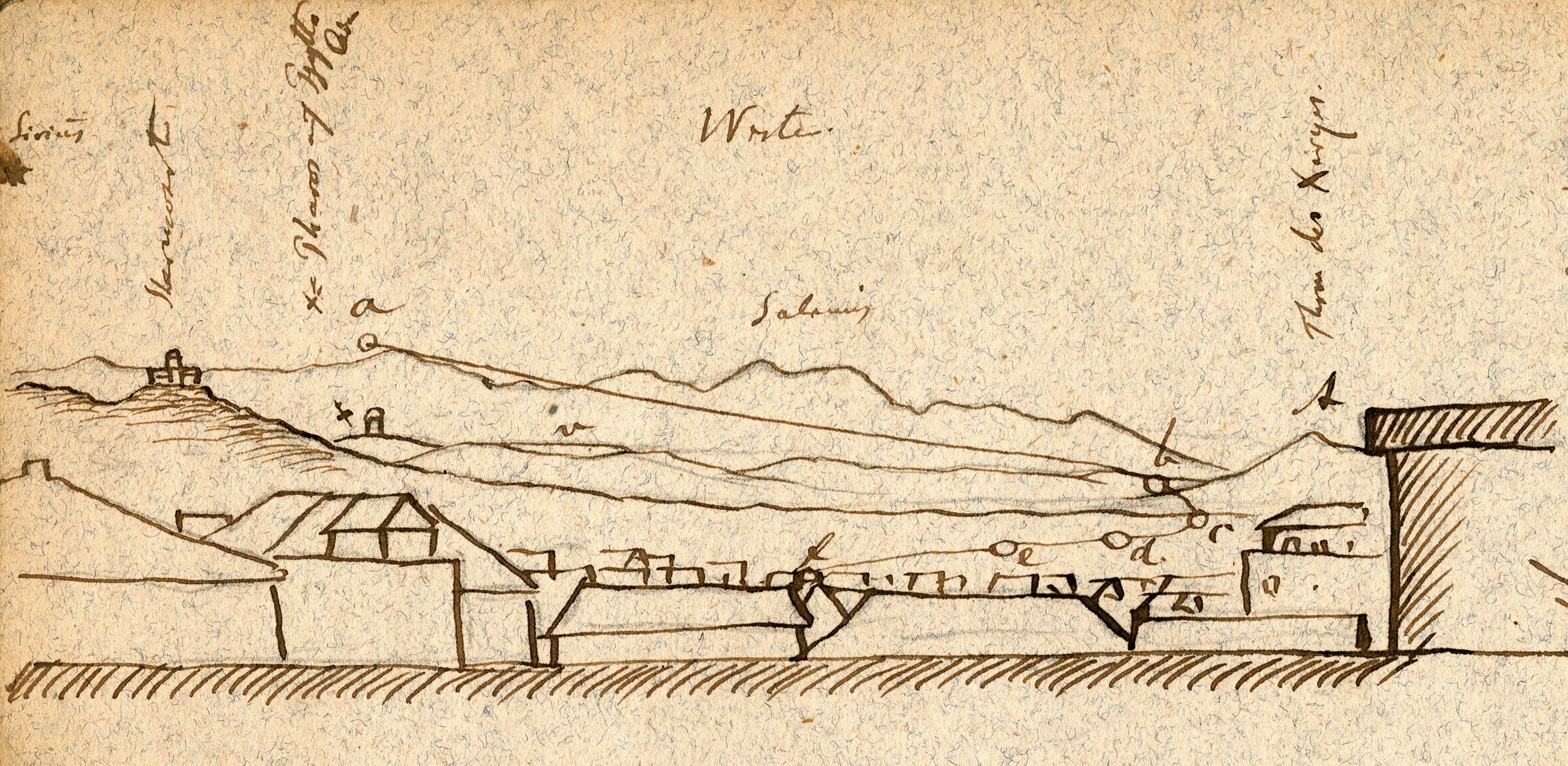
Schmidt and Curtius seem to have stayed in contact over the following years, and Schmidt visited Curtius’ excavations in Athens whenever possible. It is unclear how much Schmidt knew about the foundation of the DAI Athens beforehand, but on April 25, 1874, he noted in his diary that he had received a visit from Curtius and Johann Heinrich Friedrich Adler on the eve of their trip to Olympia (D-DAI-ATH-ARCHIV-NL-Schmidt-00002, 100) (fig. 8).

This entry refers to the beginning of the Olympia excavations, which Schmidt does not appear to have ever visited. While archaeology, and apparently also the DAI, were important subjects of discussion between Schmidt and Curtius, the two men also met at various social events, such as lectures and balls at the royal court (D-DAI-ATH-ARCHIV-NL-Schmidt-00002, 115-116). Curtius is mentioned a total of 29 times in the diary.
In March 1865, Ulrich Köhler is first mentioned in the diary. At the time, Köhler was working on the ›Corpus Inscriptionum Graecarum‹ as Secrétaire interprète for the Prussian embassy (Jantzen 1986, 16; Hallof 2012, 16 f.). A handful of meetings between the two are recorded prior to 1867, usually in informal settings such as lunches, dinners, and day trips to sites like Eleusis and Kaisariani (D-DAI-ATH-ARCHIV-NL-Schmidt-00002, 27, 30, 31, 36). Schmidt does not make mention of Köhler during the time when he was working at the University of Strasbourg (1872–1875).
In the late 1860s Schmidt had reinforced his network in Athens and met a wide variety of archaeologists and diplomats who would become close friends over the following decade.
The 1870s – the foundational years of the DAI Athens
Schmidt first met Otto Lüders, the future director of the DAI Athens, sometime in 1872 (Grigoropoulos 2023). The first mention in the diary dates to May 3, 1872 (D-DAI-ATH-ARCHIV-NL-Schmidt-00002, 91). At the time Lüders was Secrétaire interprète (like Köhler above) for the German embassy (Jantzen 1986, 16; Grigoropoulos 2023). Prior to 1874, when Lüders became the first director (›Sekretar‹) of the DAI, he and Schmidt met primarily at various social events in Athens. Even in the months after the foundation of the DAI, Schmidt makes no specific mention of Lüders’ work as its director. Schmidt was invited, however, to a baptism by Lüders in October 1875, together with Karl Wilberg, Reinhard Kekulé von Stradonitz, Friedrich Imhoof-Blumer, Emil Oberg and Diethoi (identification unclear; D-DAI-ATH-ARCHIV-NL-Schmidt-00002, 106) (fig. 9).

Schmidt noted the exact date when Lüders left office as a director of the DAI and was succeeded by Ulrich Köhler (D-DAI-ATH-ARCHIV-NL-Schmidt-00002, 107) (fig. 10).

When Lüders returned to Athens in 1877, he and Schmidt resumed their meetings, which occurred frequently until the end of the diary in 1882. The diary also shows that they often met at the royal court, at Karl Wilberg’s home, at the Hôtel d’Angleterre, at the German society ›Philadelphia‹ and at Schliemann’s famous soirées. Lüders is mentioned 91 times in the diary and seems to have been one of Schmidt’s closest friends in Athens.
After Köhler became director of the DAI in 1875, mention of him in the diary increases significantly. He and Schmidt met weekly and sometimes even daily. While their relationship may be categorized as primarily personal, Köhler appears to have played a significant role in piquing Schmidt’s interest in the newly established evening lectures and archaeological discussions at the DAI. On February 1, 1876, Schmidt noted that he spent the evening reading Aristophanes at Köhler’s (i.e. his apartment on Akademias street, in the rented building which served as headquarters of the DAI (fig. 11). Jantzen 1986, 15; D-DAI-ATH-ARCHIV-NL-Schmidt-00002, 108). This is corroborated by Köhler’s report to the central committee, in which he noted other participants such as Michael Deffner, Johann Gustav Droysen, Habbo Gerhard Lolling, Emil Oberg and Rudolf Weil (D-DAI-ATH-Archiv-B-00001) (fig. 12).


In later years, Schmidt frequently attended events at the DAI, such as the annual Winckelmann celebrations (D-DAI-ATH-Archiv-NL-Schmidt-00002, 114). He appears to have taken special interest in the Olympia excavations, which was one of the main topics in 1876 (AM 1877, 194). His diary is a very accurate source of information about various events and lectures held at the DAI, and Schmidt sometimes even recorded the names of attendees, which we can check against the list of lectures published in the Athenische Mitt(h)eilungen. Another commonality between Schmidt and Köhler was their membership in the German society ›Philadelphia‹ (D-DAI-ATH-Archiv-NL-Schmidt-00002, 116. Barth 2001, 109). Schmidt seems to have gotten on so well with Köhler and other people at the DAI that he spent Christmas eve 1876 together with them (fig. 13) (D-DAI-ATH-Archiv-NL-Schmidt-00002, 115).

The diary reflects Schmidt’s close friendship with Köhler, who is the second most frequently mentioned person, with 104 entries dedicated to meetings between the two.
Habbo Gerhard Lolling is mentioned 16 times in the diary starting in 1874, but the record appears to be biased in his case. While Lolling was working as the tutor of Karl Wilberg’s children, Schmidt frequently visited the Wilberg household, but since he was primarily meeting his old friend, he does not always mention Lolling, who was living there at the time. Only after Lolling became more involved with the DAI and started working as a librarian, does Schmidt mention him more often. On February 27, 1876 Schmidt noted that Lolling had found the site of Athene Skiras on Salamis (D-DAI-ATH-Archiv-NL-Schmidt-00002, 109. Lolling 1876b) and on August 18, 1878, he recorded a visit by Lolling, »who recently had found Prasiae« (fig. 14) (D-DAI-ATH-Archiv-NL-Schmidt-00002, 125. Lolling 1879).

Schmidt also frequently noted when Lolling had returned from one of his many trips (Matthaiou 2007, 98). Schmidt seems to have taken a keen interest in them, and the two men appear to have discussed archaeological subjects frequently. This is apparent from the fact that Schmidt provided Lolling with altitude measurements and a map of the area around Marathon for his article about Marathon’s topography (fig. 15) (Lolling 1876. I thank Katharina Brandt for this reference).
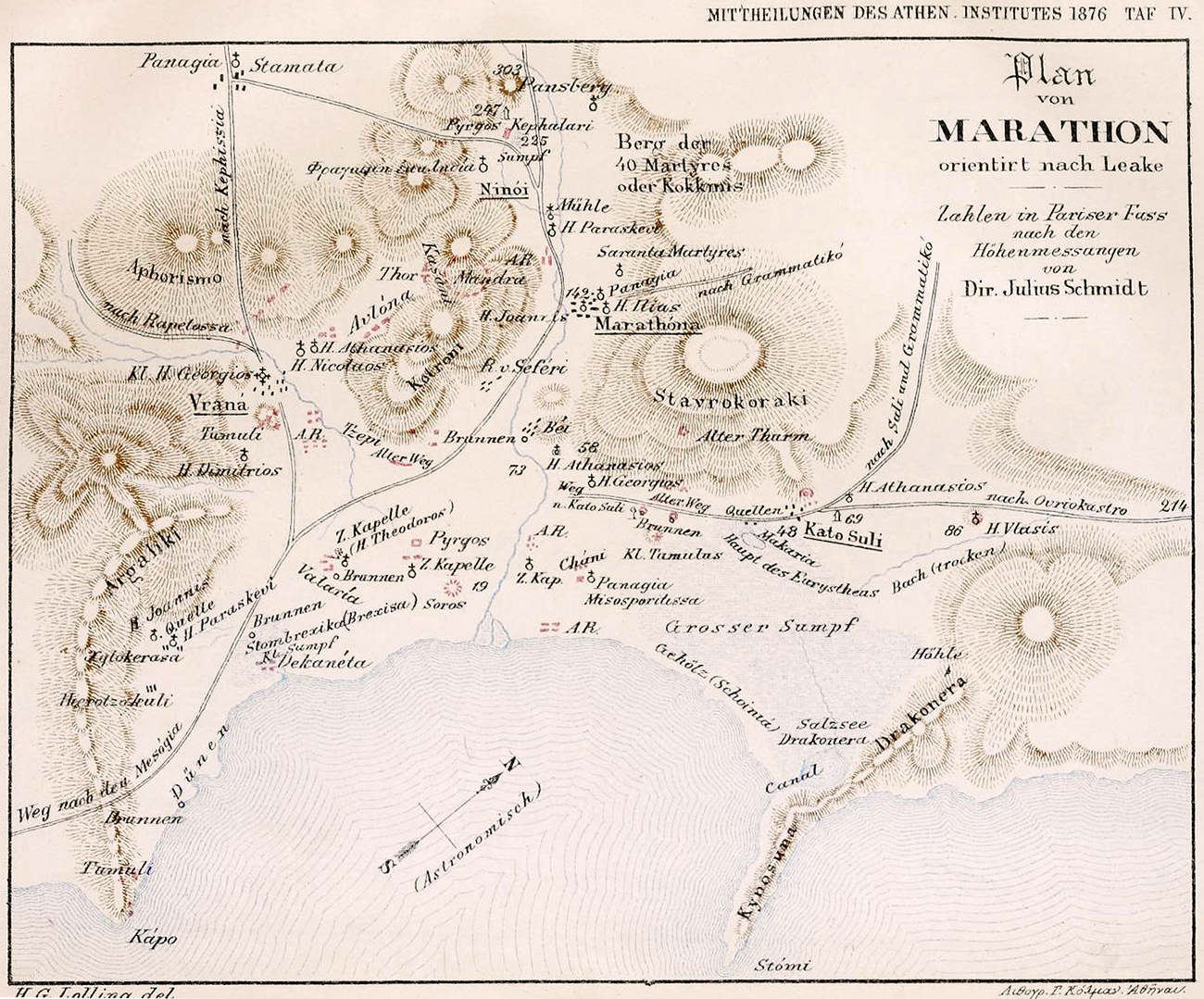
Schmidt did not record when he took the measurements in his diary, but he mentioned Marathon on September 22, 1875. The entry in question refers to the draining of the Marathonian swamp by Soutzos (D-DAI-ATH-Archiv-NL-Schmidt-00002, 105). Although this entry does not indicate whether Schmidt was there himself, it is possible that he took his altitude measurements on this occasion.
When Schmidt formally became an ordinary member (›Ordentliches Mitglied‹) of the DAI on April 21, 1877, he already had built deep relationships within the Institute. He recorded in his diary on May 16, 1877, that he received the membership certificate (fig. 16) (D-DAI-ATH-Archiv-NL-Schmidt-00002, 118). Although Schmidt wrote »deutsche archäologische Gesellschaft« (literally, “German archaeological society”), there is no doubt that he means the DAI and made a simple mistake; he was never a member of the Archaeological Society at Athens (Αρχαιολογική Εταιρεία).

By contributing to Ernst Curtius’ mapping project in 1862 and to Lolling’s article in the 1876 issue of Athenische Mitteilungen (AM), Schmidt had provided valuable resources and knowledge. His support, his close ties to members of the Institute, and his frequent attendance of events appear to have been the primary reasons for his nomination, since he never published in Athenische Mitt(h)eilungen himself or gave any formal lectures at the Institute. Schmidt’s membership was announced in Athenische Mitt(h)eilungen in 1877, and he was nominated by the Athens section of the DAI (AM 2, 1877, 195). Further archival records show that Ulrich Köhler, in keeping with his position as director had personally nominated Schmidt to the DAI’s central committee of which Curtius was a member (D-DAI-ATH-Archiv-B-00002). It is noteworthy that Schmidt was among the first members of the newly founded Athens Institute.
Another person frequently mentioned in connection with the DAI Athens is Emil Oberg, who worked as a diplomat in the German embassy and became a corresponding member of the DAI in 1877. First mention of him dates to 1875 and, he appears a total of 47 times in the diary. Schmidt’s relationship with Oberg cannot be characterized simply as a friendship. While they frequently met at various social events, dined together, and visited each other at home, Schmidt’s diary shows that their relationship also had a diplomatic dimension to it. After Schmidt had finished his map of the moon in 1875, Oberg and Kurt von Derenthal, in their capacity as diplomats, brought the original drawings to Germany to be published, exhibited, and later archived (fig. 17) (D-DAI-ATH-Archiv-NL-Schmidt-00002, 102).

In 1875, Schmidt frequently received news about the Olympia excavations from Oberg, who appears to have travelled to Olympia more than once (D-DAI-ATH-Archiv-NL-Schmidt-00002, 107). While it remains unclear whether Oberg was a member of ›Philadelphia‹, he attended the yearly festivities held there in honour of the German Kaiser (»Kaiserfest«) (D-DAI-ATH-Archiv-NL-Schmidt-00002, 122).
The 1880s – widening connections
Heinrich Schliemann is frequently mentioned in the diary starting in 1872, for a total of 31 times. While Schliemann was not yet heavily involved with the DAI Athens in the early 1870s, he was a very important member of Athens’ society. Schmidt noted Schliemann’s presence at the Winckelmann celebrations held at the DAI Athens in 1876 (D-DAI-ATH-Archiv-NL-Schmidt-00002, 114). Schliemann became a corresponding member of the DAI in 1877 (AM 1877, 195) and an ordinary member in 1885 (AM 1885, 176. Sporn 2022). Schliemann frequently hosted dinner parties, where many archaeologists and diplomats from Athens and all over the world gathered (Vogeikoff-Brogan 2022). This appears to have been the primary scene of archaeological exchange between members of the DAI and local archaeologists such as Athanasios Roussopoulos, Achilleus Postolakkas, Efthymios Kastorchis, and Stephanos Koumanoudis. Especially after the Schliemanns moved into their new home in 1880, these events became bigger, more frequent, and even better attended by people associated with the DAI Athens. On February 23, 1881, Schmidt recorded a dinner at the Schliemanns’ where Ulrich Köhler, Karl Wilberg, Athanasios Roussopoulos, Skinner, Ioannis Gennadios, and a certain Miss Mellin and Georg Treu (the latter coming from Olympia) were in attendance (fig. 18) (D-DAI-ATH-Archiv-NL-Schmidt-00002, 144).

The diary as a source for the DAI Athens
All these entries in Schmidt’s private diary show, that he was deeply involved in the life of the Institute from its early years until his death in 1884, although his last two years, from 1882 to 1884, are not recorded in the diary. In the 10 years from the foundation of the DAI Athens to Schmidt’s death, he frequently attended events at the Institute, and he recorded meetings with a total of 28 people who were members or employees of the DAI Athens. Schmidt’s immense interest in archaeology, which previously was little known, and his connections to the DAI Athens show that Schmidt was not just an astronomer. He had a profound interest in the archaeological research being conducted at the time in Greece and used his resources and expertise to facilitate archaeological projects. His diary records many lectures and events held at the DAI in its early years and is a great external source that sheds light on the networks between the DAI and other institutions and persons in Athens at the time.
Acknowledgments
First, I want to thank professor Dr. Katja Sporn for giving me the opportunity to work on Schmidt’s diary and to write this blog post. My thanks go, second, to Dr. Katharina Brandt for helping me identify many of the over 1000 people mentioned in Schmidt’s diary and for offering her almost boundless knowledge of people in Athens in the 19th century and the Institute’s history. I am also immensely grateful to Dr. Dimitris Grigoropoulos, who as an advisor on my thesis and coordinator for the project ARCHAthen, helped me understand the holdings and history of the archive of the DAI Athens and shared with me his profound knowledge of the history of the city and the Institute. I also thank Persefoni Dimitrakopoulou for providing pictures of the restored diary and explaining the restoration process in depth. I want to thank PD Dr. Andreas Zajic MAS, my primary thesis advisor, for giving me his profound insight into 19th century networks of scientists, scholars, and travellers. The scans were produced by Julia Engelhardt.
Works Cited
Brandt 2022
K. Brandt, Wilhelm Wilberg 1872–1956, in: People at the DAI Athens, 24.11.2022, https://www.dainst.blog/people-at-the-dai-athens/2022/11/24/wilhelm-wilberg-1872-1956-and-his-family/ (accessed 06.04.2023)
Curtius 1868
E. Curtius, Erläuternder Text der Sieben Karten zur Topographie von Athen (Gotha 1868)
Curtius – Kaupert 1878
E. Curtius – J. A. Kaupert, Atlas von Athen (Berlin 1878), https://doi.org/10.11588/diglit.765 (accessed 29.03.2023)
Dimitrakopoulou 2023
P. Dimitrakopoulou, Study and Conservation of Modern Manuscripts. The Case of Personal Diaries and Work Journals. Master’s Thesis at the University of West Attica, supervised by Konstantios Choulis (Athens 2023)
Dörpfeld 1896
W. Dörpfeld, Das griechische Theater. Beiträge zur Geschichte des Dionysos-Theaters in Athen und anderer griechischer Theater (Athen 1896)
Errington 2017
L. M. Errington, Otto Jahn und Adolf Michaelis. Briefwechsel 1848 bis 1869. Kommentierte Textausgabe. Beiträge zur Geschichte der Archäologie und der Altertumswissenschaften 1 (Berlin 2017)
Grigoropoulos 2023
D. Grigoropoulos, Otto Lüders 1844–1912, in: People at the DAI Athens, 17.02.2023, https://www.dainst.blog/people-at-the-dai-athens/2023/02/17/otto-luders-1844-1912-the-first-director-of-the-dai-athens (accessed 06.03.2023)
Hahn 1865
J. G. v. Hahn, Die Ausgrabungen auf der Homerischen Pergamos in zwei Sendschreiben an Georg Finlay (Leipzig 1865), https://www.digitale-sammlungen.de/de/view/bsb10256890?page=4,5 (accessed 30.08.2022)
Hallof 2012
K. Hallof, Inscriptiones Graecae. Imagines Epigraphicorum. Epigraphikerbildnisse (Berlin 2012)
Jantzen 1986
U. Jantzen, Einhundert Jahre Athener Institut 1874–1974. Das Deutsche Archäologische Institut Geschichte und Dokumente 10 (Mainz 1986)
Kern 1903
O. Kern, Curtius, Ernst, in: ADB 47, 1903, 580–597, https://www.deutsche-biographie.de/pnd116766557.html#adbcontent (accessed 14.11.2022)
Lolling 1876a
H. G. Lolling, Zur Topographie von Marathon, AM 1,1 1876, 67–94.
Matthaiou 2007,
A. Matthaiou, Ὁ Λόλλιγκ καὶ οἱ ἐπιγραφὲς των Ἀθηνων, in: K. Fittschen (Ed.), Historische Landeskunde und Epigraphik in Griechenland. Akten des Symposiums veranstaltet aus Anlaß des 100. Todestages von H.G. Lolling (1848–1894), Athen 28.–30.09.1994 (Münster 2007), 97–108
Matsopoulos 2022
N. Matsopoulos, Johann Friedrich Julius Schmidt, Direktor der Sternwarte von Athen (1858-1884), in: A. A. Kyrtsis – M. Pechlivanos (Ed.), Compendium der deutsch-griechischen Verflechtungen, 14.03.2022, <https://comdeg.eu/compendium/essay/110141/> (accessed 16.08.2022)
Schmidt 1878
J.F.J. Schmidt, Charte der Gebirge des Mondes (Berlin 1878)
Schmidt 1881
J.F.J. Schmidt, Studien über Vulkane und Erdbeben (Leipzig 1881), <https://books.google.gr/books?id=TIguAAAAIAAJ&hl=de&source=gbs_navlinks_s> (accessed 13.10.2022)
Sporn 2022
K. Sporn, Heinrich Schliemann 1822-1890, in: People at the DAI Athens, 28.02.2022, <https://www.dainst.blog/people-at-the-dai-athens/2022/02/28/heinrich-schliemann-1822-1890/> (accessed 06.03.2023)
Vogeikoff-Brogan 2022
N. Vogeikoff-Brogan, At home with the Schliemanns. The Iliou Melathron as a Social Landmark, in: From the Archivist’s Notebook, 06.01.2022, <https://nataliavogeikoff.com/2022/01/06/at-home-with-the-schliemanns-the-iliou-melathron-as-a-social-landmark/> (accessed 06.03.2023)
Wieseler 1862
F. Wieseler, Zur Kunde über das Dionysische Theater zu Athen, Philologus 18, 1862, 748–750
AM 1877
Mitteilungen des Deutschen Archäologischen Instituts Athenische Abteilung 2, 1877, <https://doi.org/10.11588/diglit.29491#0227> (accessed 17.08.2022)
AM 1885
Mitteilungen des Deutschen Archäologischen Instituts Athenische Abteilung 10, 1885, <https://doi.org/10.11588/diglit.42074#0192> (accessed 12.10.2022)
